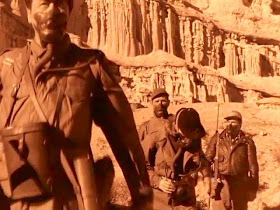 |
| Percy Helton gives Kaye and Der Bingle a hard time |
Grateful that he saved his life in WW2, singer Bob Wallace (Bing Crosby) teams up with his buddy, Phil Davis (Danny Kaye) when they return to civilian life. The two become a rich and successful team, and are called upon to advise the singing sister duo of an old Army buddy. Bob falls for Betty (Rosemary Clooney) and Phil has special feelings for Judy (Vera-Ellen). However, there are complications, and the two men follow the gals to their engagement at an inn in Vermont, which turns out to be owned by their former commanding officer, General Waverly (Dean Jagger). Can they do something to win the girls' hearts and save the inn and the general from bankruptcy? The first picture presented in VistaVision, White Christmas is amiable enough, but aside from some standard tunes by Irving Berlin, it's minor, and the plot is a dog. Der Bingle and Kaye play well together, as do the two gals, with Clooney giving a truly warm and sympathetic performance. Vera-Ellen is a terrific dancer primarily, and she struts her stuff in one number with a male partner, and yet another set to the tune of "Mandy" (which I'd always believed was composed by Victor Herbert but is actually a bonafide Berlin tune). One interesting thing about the movie is that while it's basically fluff, it begins with a rather somber sequence overseas near the end of the war -- while the two men sing the wonderful "White Christmas" there are shots of the homesick soldiers, near tears, thinking about their families back home. However, the attempt to create another lump in the throat with a climactic tribute to the general doesn't quite work -- surely a simple reunion would have made more sense, but this is Hollywood and you need a big finish! The performances from the leads and Jagger are all good, Mary Wickes shows up as a housekeeper at the inn (but her scenes are limited, unfortunately), and we even get the ubiquitous Percy Helton as a train conductor interacting with Bing and Danny! The gals' big number, "Sisters," has pretty much become high-camp and the quartet"s "Snow" is Berlin at his worst.
Verdict: Nice songs and dancing but once is enough. **1/2.



































